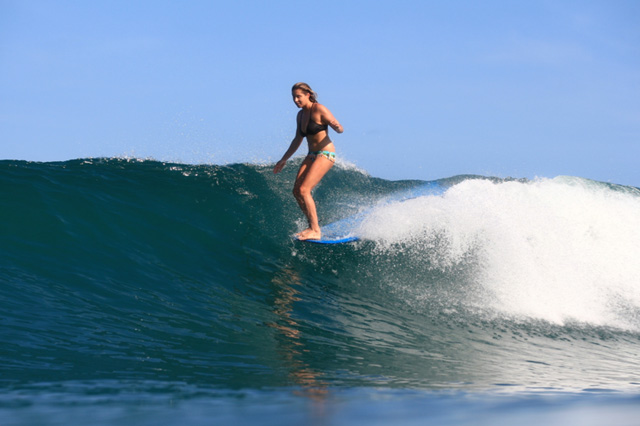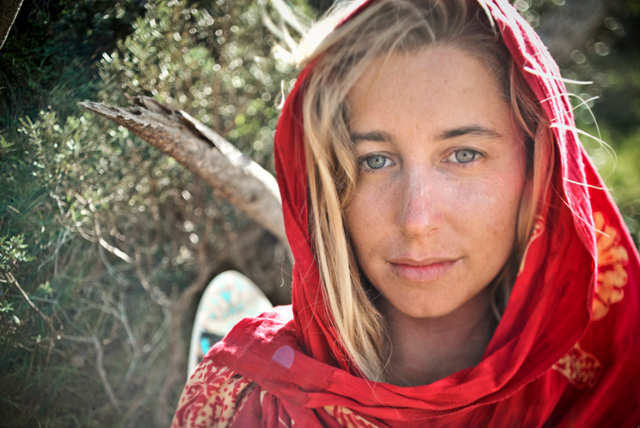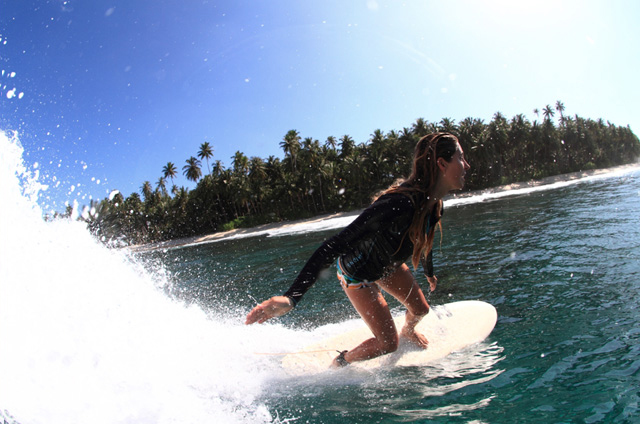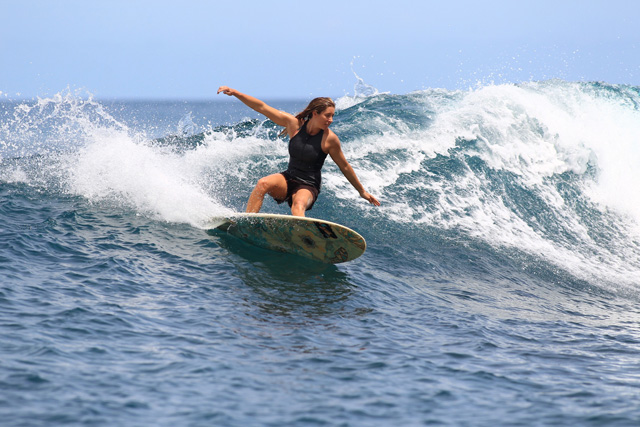 |
| Photo of Lauren Hill by Swilly |
We are continually inspired by intelligent lady gliders whose extracurricular passions include making art and doing good. Environmental activist Lauren L. Hill is wholeheartedly all of the above and more.
We were pen pals with Lauren before meeting her in person in Pisa, Italy after we came back from the girls surf trip in Sardegna.
Lauren currently lives between Florida (she was born in St. Augustine and grew up on Anastasia Island) and Byron Bay, Australia where her schedule is dictated by when’s the best time to surf. We caught up with Lauren to learn more about her many irons in the fire: a documentary surf filming trip to India; educating about gas drilling in Australia and her zine Sea Kin. The zine and website is a dense collection of stories and images compiled by famous surfers and relative unknowns that’s captivating from page to page. It swallowed up our afternoon in escapism like a good book while on vacation.
Read on to hear Lauren’s insight on the male/female dynamic in surfing cultures across the globe and what it means to label yourself as a feminist today.
 |
| Portrait of Lauren Hill by Takanami |
Interview by Rhea Cortado
You call both Florida and Australia your home. Besides the surf, what about the culture of those two places makes them home?
I love the slow pace of Florida and, maybe more than anything else, I love the food: datil pepper sauces, lemony sweet tea, boiled peanuts and black bean burritos are basically a recipe for home.
Floridian surfers have exceptionally low standards for surf, and I take a bit of pride in that. Haha. We are born and bred with an appreciation for anything rideable, because the surf doesn’t get amazing all that often.
In my experience, Australians are comparatively quite snobby when it comes to judging the surf. But they have every right to be. You have to be picky as a surfer in Australia, because you could spend every waking hour getting good surf, by Floridian standards.
I love the beach culture of Australia. I guess it makes me feel less like a beach bum odd-ball when I’m surrounded by lots of others who really just want to be playing in the ocean all of the time. And they actually make it a priority. I also love Australian humor. They have a way of not taking things so seriously that is so very different from American culture.
What does the day-to-day of Lauren Hill look like?
For the past few years I’ve had distinct 6-month spells that are starkly different. I try to spend the first half of the year in Australia and then the [second] half of the year traveling with Florida as a home base.
I’m a bit of a homebody, so I really love staying still for the first half of the year. If there is surf (and there usually is), a typical day revolves around swell, wind and tides. My favorite days are when I get to ride a shortboard at one of the punchier points in the morning, followed by a big lunch of veggies from our garden, a sunset longboard slide in Byron, and then just collapsing in bed from surf exhaustion afterward. In between surfs are for writing, reading, gardening, nap taking, or researching.
As a female, how do you find the surf culture different from the US versus Australia? Is the male/female surfing culture dynamic different in Aus?
Surfing is taken much more seriously in Australia. It’s considered a “real” sport that garners the attention of the nightly news and the headlines of newspapers.
I definitely feel the gender divide more strongly in Australia, especially in the water. The history of Australia is a very rough, rugged and masculine one, and those characteristics still define a lot of Australian life. I know a number of well-traveled women who find Australian men to be some of the most generally chauvinistic of any they’ve met. I’m not sure whether or not I agree, but I definitely witness a good bit of macho-aggression in the water here.
With that said, there are probably more women surfing in Byron (where I live) than anywhere I’ve traveled to in the world. It’s awesome! It feels much more natural and inviting to have both women and men in the line-up. So, it’s a bit of an empowered feminine bubble that I live in, getting to be around so many women surfers, but I prefer it that way. Most of the men in the line-up aren’t complaining, either.
 |
| Photo of Lauren Hill by Swilly |
|
Tell us more about your environmental activism work. What are your current projects and how can we get involved?
I’m working on a few projects at the moment:
1. The threat of Coal Seam Gas in our backyards here in Australia is really disconcerting, especially the inevitable poisoning of water that occurs as a causality of the process. Last weekend I visited another one of the exploratory drill sites in our area. It was perturbing to see drills already in the ground, hunting for gas so near to home, and so close to world class surf breaks. The local community there has been demonstrating for weeks, trying to ward off Met Gas Co. from carrying on, but to no avail. The amount of shortsighted greed and destruction involved in CSG in unthinkable. We must prevent these corporations from pillaging our homelands and waters. To get educated and involved read here. And watch: 101 East: Risky Business on Youtube.
2. I’m helping with The Economics of Happiness Conference here in Byron, held at the community centre March 15th-17th. It’s an amazing gathering of thinkers and activists from around the world who will speak and hold workshops about localization. All kinds of topics will be covered, including education, economics, art, surfing, health, community, and ecology, for example.
3. In April I’ll be traveling to India with a crew of four other lady sliders for the first all-female surfing/humanitarian documentary trip:
"With unshakable determination for a better world, we—Crystal Thornburg-Homcy, Liz Clark, Emi Koch, Ishita Malaviya and Kate Baldwin and myself—will travel through Southern India. Our goal is to document the ways that surfing, yoga, and ecological creativity are bringing hope and fueling change for local people and the Planet. We’ll be making a film of the journey. Help us fund the trip!
What do you find are the biggest challenges when you are educating people about environmentalism? What is your approach to overcoming those?
I don’t really aspire to educate people, I just like to share what I’ve learned and experienced. Most people are more receptive to hearing first hand accounts instead of abstract facts and figures. And that’s the real strength and importance of surfers being environmental custodians—we’re canaries in the coalmine. We’re not in labs studying the slow decay of marine ecosystems, we get sick from ocean water filled with runoff and we are on the beaches that are littered with plastics. I appreciate book learning, but experiential knowledge helps bring environmental issues to life.
I tend to find trying to share ideas about gender much more challenging than talking about environmental issues. Most people can see the ways that we are altering our planet now, but it’s much more difficult for most to clearly see something as deeply ingrained as gender and how destructive rigid conceptions of gender can be for men and for women.
 |
| Photo of Lauren Hill by Swilly |
You've said that you support feminist and ecofeminist issues--what does it mean to be a feminist today? Why is it important, especially as a surfer?
Feminism means standing up for equality and recognizing that the feminine has traditionally been overlooked and undervalued.
For example, women and men tend to surf differently. Instead of celebrating this, most people (women included) tend to judge women as inferior surfers. The way men surf has been accepted as the best way. In reality, women’s surfing tends to emphasize characteristics that are just different to the way men ride waves.
Feminism means that all people should have the right to choose how they want to be, unfettered by social impositions of how they “should” be.
Feminism is about supporting men AND women. Men have just as many crazy expectations placed on them as women—to look and act in certain ways—and men suffer from those pressures just like we do. Most men in western cultures have essentially been taught to deny any semblance of femininity. And that’s not fair, or possible, for any holistically healthy human, in the same way that it’s crazy to deny that all women also possess what we call “masculine” traits.
So many women of my generation and younger are terrified of the word feminist. They associate it with being angry, man bashing or think that it’s no longer relevant. It’s such a shame.
We need look no further than our own surfing culture to see gender imbalances at work. One of the founding missions of second wave feminism was to attain equal pay for equal work for women and men. Today in the US women still only earn .76 cents on the dollar for what a man earns for doing the same job. And if you want to see extreme inequality, look at the pay gap between women and men on the ASP world tour. Women are able to earn only a fraction of what men earn for winning contests. I don’t really follow contests or care much for them, but it’s still not fair, and it’s undeniable proof of the devaluation of women’s work and unique talents.
 |
|
Sea Kin is a really impressive collection with a variety of stories and diverse contributors. How did you compile submissions? How did you choose what made it in the magazine?
Thank you. The Sea Kin ‘Zine is basically a compilation of surf culture the way that I see it. The articles and imagery are all by and about my friends, really. It’s filled with the musings of creative, passionate, and open-hearted sea kin, united by our love of the ocean and envisioning different paths for what it means to be a surfer.
 |
| Images from Sea Kin zine |
What is your vision for the Sea Kin blog and website?
I’d love for it to be a hub for creative thinkers, sliders, and do-ers; a place to share the stories that are so often overlooked by mainstream surf media.
We know picking a favorite board is like picking a favorite child. But which boards in your quiver do you find yourself reaching for most often lately?
My go to log is a Bing Silver Spoon; I basically never travel without it (which can be incredibly frustrating at times, due to its size and weight). I love the subtlety of small waves and there’s nothing like the glide of a heavy single fin log. Lately, I’ve also been loving my 7’3 Bing Raven single fin. It’s so playful.
I see so many cute surf wetsuits, swimwear and lifestyle women’s brands come out of Australia! What is it about the culture and people there that is conducive to creativity and those products?
I think that the average Australian woman tends to be more fashion-forward than the average American gal. When you combine that passion for fashion with the outdoorsy nature of Australian life, it seems like we end up with some pretty innovative takes on surf wear.
Sometimes the more popular line-ups around here look like fashion parades—filled with women and men getting really into what they wear in the water. As long as people are having fun, it’s awesome.
What are some of the most valuable lessons that surfing taught you?
To be still and listen.
 |
| Photo of Lauren Hill by Dawe |
]]>
 We subscribe to the idea that adventure is when nothing goes as planned..
We subscribe to the idea that adventure is when nothing goes as planned..













